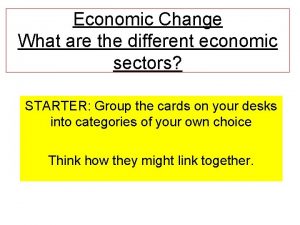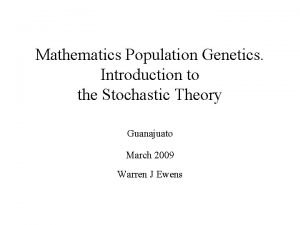GETTING TO YES Yes Roger Fisher William Ury




















































- Slides: 52


GETTING TO YES (Yes를 이끌어 내는 협상법) 하버드대 협상 프로젝트 Roger Fisher William Ury Bruce Patton





이제까지의 협상의 전형적 형태 Soft Negotiation Hard Negotiation ¢ Participants are friends ¢ The goal is agreement ¢ Make connections to cultivate the ¢ Participants are adversaries ¢ The goal is victory ¢ Demand concessions as a condition of the ¢ ¢ ¢ ¢ relationship Be soft on the people and the problem Trust others Disclose your bottom line Accept one-sided losses to reach agreement Search for the single answer: the one they will accept Insist on agreement Try to avoid a contest of wills Yield to pressure ¢ ¢ relationship Be hard on the problem and the people Distrust others Dig in to your position Make threats Don’t discloses your bottom line Demand one-sided gains as the price of agreement Search for the single answer: the one you will accept Insist on your position Try to win a contest of wills Apply pressure


1장. Positional Negotiation ¢ Produce unwise agreements (바람직하지 않은 결과를 낸다) ¢ Inefficient (효율적이지 않다) ¢ Endangers an ongoing relationship (기존 관계를 위험에 빠뜨린다) ¢ Gets worse with many parties involved (협상참여자가 다수인 경우 문제를 더욱 어렵게 만 든다) ¢ ¢ Soft/Hard positional negotiation (연성과 강성의 협상태도가 있다)



Principled Negotiation의 4개 기본 요소 People Separate the people from the problem Interest Focus on interests not positions Option Invents options for mutual gain Criteria Insist on using objective criteria

제 2부 The Method 방법론

Be soft on the people and hard on the problem People Separate the people from the problem Interest Focus on interests not positions Option Invents options for mutual gain Criteria Insist on using objective criteria BATNA Know your BATNA (Best Alternative to Negotiated Agreement)








Interest란? ¢ 인간의 기본적인 욕구 충족 ¤ 안전 보장 (Safety) ¤ 경제적 행복 (Economical happiness) ¤ 소속의식 (Belonging to, Love) ¤ 인정 (Recognition and Self-esteem) ¤ 자기 삶에 대한 관리 (Self-actualization)

4장. Invent OPTIONS for Mutual Gain ¢ DIAGNOSIS ¤ Premature JUDGEMENT ¤ Searching for the single answer ¤ The assumption of a fixed pie ¤ Thinking that “solving their problems is theory problem. ” ¢ 진단: 풍부한 옵션을 창안에 방해 물 ¤ 성급한 판단 ¤ 유일한 해결책을 찾으려는 태도 ¤ 파이의 크기가 정해져 있다는 생각 ¤ 상대방의 무제는 상대방이 해결해야 한다는 생각 ¢ PRESCRIPTION ¤ Invent first, decide later ¤ Broaden options ¤ Search for mutual gains ¤ Make their decisions easy ¢ 처방 ¤ 창안 먼저 결정은 나중에 ¤ 옵션의 폭을 넓혀라 ¤ 쌍방의 이익을 추구하라 ¤ 상대방이 쉽게 결정할 수 있게 해주라

Conduct Brainstorming ¢ Before Brainstorming 1. Define your purpose 2. Choose a few participants 3. Change the environment 4. Design an informal atmosphere 5. Choose a facilitator ¢ During Brainstorming ¤ Seat the participants side by facing the problem ¤ Clarify the ground rules, including the no-criticism rule ¤ Brainstorm ¤ Record the ideas in full view ¢ After Brainstorming ¤ Start the most promising ideas ¤ Invent improvements for promising ideas ¤ Set up a time to evaluate ideas and decide ¢ Consider Brainstorming with the other side

Broaden options ¢ Circle charts ¢ 특수한 것과 일반적인 것 사이를 ¢ Look through the eyes of 오가면서 옵션을 늘려라. 도표를 이용하라 ¢ 여러 전문가들의 눈을 통해 보자 ¢ 강도가 서로 다른 합의들을 창출 하라 ¢ 제안된 합의의 범위를 변화시켜라 different experts ¢ Invent agreements of different strengths ¢ Change the scope of a proposed agreement





Make their decision easy ¢ Whose shoes? Focus on one person ¢ 상대 회사의 어느 누구의 처지를 ¢ What decision? Give an easy 고려해야 하는가? (Key decision maker) ¢ 상대방이 어떤 결정을 하도록 해 야 하는가? ¢ 상대가 ‘Yes’할만한 제안을 만 들어라 decision ¢ Make offers, consider consequences

5장. Insist on using Objective CRITERIA ¢ Commit to reaching a solution based on principles ¢ Develop objective criteria ¤ Fair standards ¤ ¤ Market value, scientific judgement, professional standards, moral standards, tradition … Fair procedure ¤ One cuts, te other chooses, taking turns, drawing lots, letting someone else decide… ¢ Negotiate with objective criteria ¤ Frame each issue as s joing search for objective criteria ¤ Reason and be open to reason ¤ Never yield to pressure, only to principle ¢ 객관적 기준을 사용할 것을 주장하라 ¤ 의지에 근거한 결정에는 큰 대가가 따른 다 ¤ 원칙화된 협상은 우호적이고 눙률적으로 현명한 합의를 낳는다 ¢ 객관적 기준의 개발 ¤ 공정한 기준: 시장가격, 볍정가격, 선례, 도덕적 기준, 과학적 판단, 동등한 대우, 전문적 기준, 전통적 기준, 효율성, 상호 성, 비용, 기터 ¤ 공정한 절차 ¢ 객관적 기준에 근거한 협상 ¤ 객관적 기준의 공동 탐색 ¤ 논리적으로 설득하고 논리에 승복 ¤ 압력에 절대로 굴하지 말라


What if… 그런데 만약… ¢ What if they are more powerful? ¢ What if they won’t play? ¢ What if they use dirty tricks?

6장. What if they are more powerful? ¢ Negotiate on merits, develop your BATNA to increase your negotiation power ¢ 2 Objectives ¤ Protect you against making an agreement you should reject ¤ Make the most of the assets you do have ¢ How ¤ The cost of using a bottom line ¤ Develop your BATNA ¤ Judge every offer against your BATNA ¤ Consider of exposing our BATNA ¤ Consider the other side’s BATNA ¤ Formulate a trip wire ¢ 어쩔 수 없이 합의하지 말고 최선 의 대안(BATNA*)을 미리 개발하라 ¤ 목적 ¤ Bottom line을 선택하는 경우 피하라 ¤ 최저선의 대안을 체계적으로 세우라 ¤ 모든 자산을 최대한 활용하라 ¤ 당신의 BATNA가 좋을수록 당신의 협상 력은 강해진다 ¤ 당신의 BATNA를 개발하라 ¤ 상대방의 BATNA를 고려하라 * BATNA: Best Alternative to Negotiated Agreement

7장. What if They Won’t Play? ¢ Center on what you do - on principled negotiation ¢ 당신이 할 수 있는 것에 집중하라 : 원칙적 협상 (Principled negotiation) ¢ Focus on what they may do– Negotiation jujitsu ¢ Focus on what a third party can do – one-text procedure ¢ 주짓수 기술을 활용하라 ¤ 상대방의 관심을 이점으로 돌려 입장 을 근거로 거래하는 근본적 조치에 반 격을 가함 ¢ 단일 텍스트 중재 방법 (제 3자 중 재)

Negotiation Jujitsu ¢ Do not push back – sidestep their attack and deflect it against the problem ¤ Treat their position as an option, ¤ ¤ ask for reason behind Invite criticism and advices on your ideas Recast an attack on you as an attack on the problem Use questions instead of statements Use silence ¢ 상대방의 입장을 공격하지 말고 그 입장의 이면을 보라 ¢ 당신의 아이디어를 방어하지 말고 상대방의 비판과 조언을 구하라 ¢ 당신을 향한 인신공격을 당면 문 제를 향한 공격으로 바꾸라 ¢ 질문 후에는 침묵을 지켜라

One-text procedure ¢ Use of mediator ¢ Mediator works with 2 sides, prepare drafts from their interests until no ore improvements can be made, provide the final one-text, leave option of Yes and No to related parties ¢ 단일 텍스트 중재안 ¤ 제 3자 활용 ¤ 중재자가 당사자들의 이해관계에 대해 충분히 들어본 뒤 단일 안을 만들어서 양자에게 YES인지 No인지 만을 선택하 도록 하는 방안.

8장. What if they use dirty tricks? ¢ Recognize the tactic ¢ 그들의 수법을 인지하라 ¢ Raise the issue explicitly ¢ 이슈를 분명하게 제기하라 ¢ Question the tactic’s ¢ 그들의 술법의 적법성 문제와 협 legitimacy and desirability ¢ Use principled negotiation: people, interest, options and objective criteria ¢ Turn to your BATNA and walk out as last resort ¢ Don’t be a victim : be prepared to fight dirty bargaining tactics 상에 바람직한 행위인지 질문하라 ¢ 그리고는 다시 “principled negotiation” 을 따르라 사람과 문제를 구분하라 ② 입장이 아니라 이해관계에 집중하라 ③ 상호이익을 얻을 수 있는 옵션 개발 ④ 객관적 기준을 주장하라 ① ① 당신의 BATNA로 돌아가 집중하라 ② 희생양이 되지 말라


Continued from common tricky tactics… ¢ Positional Pressure Tactics ¤ ¤ ¤ ¤ Refusal to negotiate: talk about their refusal to negotiate, insist on using principles Extreme demands: ask for principled justification of their position until it looks ridiculous eve to them Escalating demands: call it to their attention, take a break, insist on principles Lock-in tactics: depends on communication interrupt the communication Hardhearted partner: get agreement to the principles involved in writing, speak directly with the “hardhearted” partner A calculated delay: look for objective conditions that can be used to establish deadlines “Take it o leave it”: consider ignoring it first, introduce ore solutions, if you use this tactics, let them know what they will have to lose if no agreement is reached and look for a facesaving way. ¢ 포지션에 근거한 위협 수법들 ¤ 협상 결렬 ¤ 과도한 요구 ¤ 요구수준의 계속적인 상향 조정 ¤ 핸들 뽑아버리기 ¤ 강경파 동요 활용하기 ¤ 의도적 지연 전술 ¤ 선택 강요

제 4부 in conclusion 결 론


One page summary ¢ Principled Negotiation ¤ People: Separate the people from the problem ¤ Interest: Focus on Interests, not positions ¤ Options: Invent options for mutual gains ¤ Criteria: Insist on using the objective criteria ¢ Develop your BATNA to increase negotiation power ¢ Don’t be a victim of dirty bargain tricks ¢ 원리에 입각한 협상법 ¤ 사람과 문제를 구분하라 ¤ 입장이 아니라 이해관계에 초점을 맞 춰라 ¤ 모두에게 이익이 되는 옵션을 개발하 라 ¤ 불리해지면 객관적 기준을 주장하라 ¢ BATNA를 개발하라 ¢ 더러운 술책에 희생양이 되지 말 라

10 Frequent Questions Dose positional bargaining ever make sense? 2. What if the other side believes in a different standard of fairness? 3. Should I be fair if I don’t have to be? 4. What do I do if the people are the problem? 5. When does it make sense NOT to negotiate? 6. How should I adjust my negotiating approach to account of differences of personality, gender, culture and so on? 7. How do I decide things like: where should we meet? Who should make the first offer? How high should I start? 8. Concretely, how do I move from inventing options to making commitments? 9. How do I try out these ideas without taking too mucj risk? 10. Can they way I negotiate really make a difference, if the other side is more powerful? How do I enhance my “negotiating power? ” 1.


Any more questions?






 William ury third side
William ury third side Brandon witte
Brandon witte Yes i said yes i will yes analysis
Yes i said yes i will yes analysis I m trading
I m trading Getting ahead
Getting ahead Theories of intellectual property william fisher
Theories of intellectual property william fisher Trading
Trading Chaz fisher
Chaz fisher Aparato de fisher johns
Aparato de fisher johns Thermo fisher core values
Thermo fisher core values Robin and jay poem
Robin and jay poem Colleen fisher uwa
Colleen fisher uwa Fisher house kahn
Fisher house kahn Fisher féle volumenindex
Fisher féle volumenindex Vassilis athitsos
Vassilis athitsos Rob fisher cause of death
Rob fisher cause of death Fisher's exact test
Fisher's exact test Mr zeev duieb
Mr zeev duieb Coeficiente de asimetría de fisher
Coeficiente de asimetría de fisher Simplified fisher equation
Simplified fisher equation Clark fisher model uk
Clark fisher model uk Fisher race nomenclature
Fisher race nomenclature Direct and indirect behavioral assessment
Direct and indirect behavioral assessment Formula for simple aggregate price index
Formula for simple aggregate price index Fisher house west palm beach
Fisher house west palm beach Distinguish between fisher and cambridge equation
Distinguish between fisher and cambridge equation Kiss of the vampire poster representation
Kiss of the vampire poster representation Ciri-ciri distribusi f
Ciri-ciri distribusi f Peter fisher mit
Peter fisher mit Narrative paradigm walter fisher
Narrative paradigm walter fisher Real interest rate formula economics
Real interest rate formula economics Inverse fisher transform
Inverse fisher transform Função linear
Função linear D-psicose fischer projection
D-psicose fischer projection Darleen fisher
Darleen fisher Avery fisher center
Avery fisher center Giles fisher waitrose
Giles fisher waitrose Fisher exact test
Fisher exact test Enantiomeros
Enantiomeros Assumptions of quantity theory of money
Assumptions of quantity theory of money Fisher house albany ny
Fisher house albany ny Công thức fisher
Công thức fisher Együttes értékindex
Együttes értékindex Frank fisher
Frank fisher Copyright
Copyright Fisher's runaway hypothesis
Fisher's runaway hypothesis Thermo fisher scientific vision statement
Thermo fisher scientific vision statement Fisher exact test sas
Fisher exact test sas Tangerine paul fisher
Tangerine paul fisher Tabla de distribucion de fisher
Tabla de distribucion de fisher Fisher separation theorem graphically
Fisher separation theorem graphically Brendan fisher uvm
Brendan fisher uvm Fisher model
Fisher model









































































